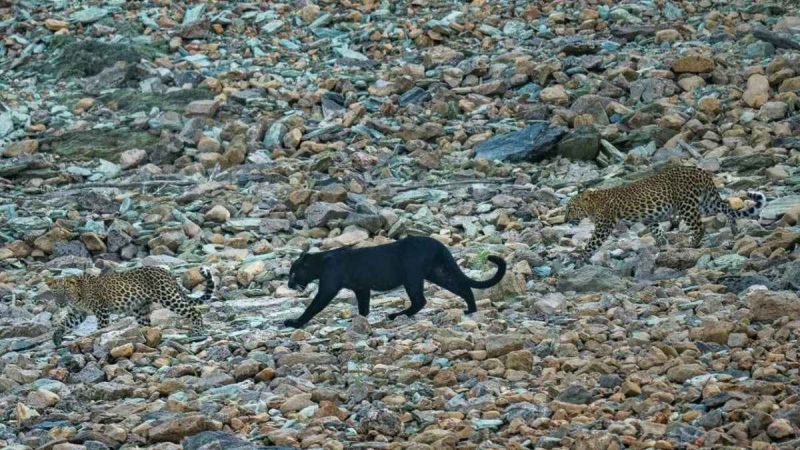Step into an Indian forest at dusk, and you might see movement in the undergrowth: a ripple of muscle or a flick of a tail. If the light fails you, the forest might suddenly feel haunted. That shadow could be a melanistic leopard, often sensationally called the “black panther.” Unlike its nickname suggests, it isn’t a separate species. It’s the same Indian leopard (Panthera pardus fusca), but cloaked in darkness by a genetic twist called melanism.
The Enigmatic Melanistic Leopard: India’s Shadow Cat
The trait of melanism, caused by excess melanin in the skin and hair, leaves the coat so dark that it appears jet black. Yet under direct sunlight or camera flash, the leopard’s familiar rosettes surface faintly, as if painted in a watermark. Melanism is recessive; both parents must carry the gene for the offspring to inherit it. Scientists estimate that around 11% of India’s leopards show melanism, though spotting one in the wild is rare enough to spark headlines.
Among the handful of places where the shadow cat has been recorded, Bhadra Wildlife Sanctuary in Karnataka holds a special reputation. Its landscape of moist deciduous forests, rugged ridges, and altitudes rising to 1,875 metres creates ideal cover for leopards. Tigers roam here, and so do wild dogs, gaurs, and hornbills. But it’s the melanistic leopard that has given Bhadra its mystique.
Unlike more commercialised tiger reserves, Bhadra is relatively quiet. The lack of heavy tourist traffic means the forest keeps its secrets longer.
India’s Wider Network Of Sightings
Bhadra doesn’t stand alone. The animal has been photographed across several landscapes:
- Kabini, Nagarhole Tiger Reserve (Karnataka): It is home to the famed melanistic leopard nicknamed Saya, whose images circulate globally.
- Kali Tiger Reserve (Karnataka): Camera traps here reveal melanistic leopards in about 14% of leopard captures, a surprisingly high ratio.
- Nilgiri Hills (Tamil Nadu): Here, occasional sightings spark comparisons to Bagheera, Kipling’s most famous creation.
- Madhya Pradesh and Odisha: Fresh surveys confirm their presence. Odisha has even recorded melanistic mothers with cubs.
The rise in sightings tempts optimism, but conservationists are cautious. Are numbers really increasing, or are fragmented forests forcing leopards closer to human eyes? The latter could spell trouble. Loss of habitat remains the largest threat, not just to tigers and elephants, but to the subtle variations like melanism that make wildlife endlessly diverse.
India is one of the only countries where this phenomenon is not folklore but reality. And in places like Bhadra, with its thick canopy and quiet trails, the possibility of seeing one lingers. In the end, spotting this shadow cat is not just a wildlife sighting, it feels like stumbling into nature’s glorious experiment!
Cover Image Courtesy: susantananda3/X
For more such snackable content, interesting discoveries and the latest updates on food, travel and experiences in your city, download the Curly Tales App. Download HERE.

